Compressive strength prediction of fly ash/slag-based geopolymer concrete using EBA-optimised chemistry-informed interpretable deep learning model
IF 8.2
2区 工程技术
Q1 CONSTRUCTION & BUILDING TECHNOLOGY
引用次数: 0
Abstract
Geopolymer concrete (GPC) is a sustainable alternative to conventional Portland cement concrete, utilising industrial by-products like fly ash (FA) and ground-granulated blast-furnace slag (GGBS). However, optimising GPC's compressive strength (CS) often requires costly and time-consuming experimental trials. This study develops a deep learning (DL) model based on convolutional neural networks (CNN) to predict the CS of FA/GGBS-based GPC. The model integrates key mix parameters such as material proportions, curing conditions, and the chemical composition of FA/GGBS binders, making it chemistry-informed. The CNN architecture includes two convolution layers, global max-pooling, and two fully connected layers, with 11 input variables and a single output for CS prediction. To optimise model accuracy, the enhanced bat algorithm (EBA) is designed for metaparameter tuning. The model is trained and tested on a comprehensive dataset comprising experimental data extracted from published literature. The results demonstrate that the EBA-optimised CNN outperforms traditional learning models, including support vector machine (SVM), extreme gradient boosting (XGBoost), and artificial neural networks (ANN), with higher performance in terms of R2, MAE, and RMSE. The model achieved R2 values of 0.997 for training and 0.978 for testing. Additionally, the Shapley additive explanations (SHAP) method was used to interpret the model, identifying the Na2O to binder ratio and curing age as the most influential factors on CS. This study highlights the potential of DL techniques, particularly chemistry-informed CNN with metaparameter optimisation, for accurately predicting the strength of GPC, providing a cost-effective solution for mix design and performance evaluation.
利用eba优化的化学信息可解释深度学习模型预测粉煤灰/矿渣基地聚合物混凝土的抗压强度
地聚合物混凝土(GPC)是传统波特兰水泥混凝土的可持续替代品,利用工业副产品,如粉煤灰(FA)和磨粒高炉渣(GGBS)。然而,优化GPC的抗压强度(CS)往往需要昂贵且耗时的实验试验。本研究开发了一种基于卷积神经网络(CNN)的深度学习(DL)模型来预测基于FA/ ggbs的GPC的CS。该模型集成了关键的混合参数,如材料比例、固化条件和FA/GGBS粘合剂的化学成分,使其具有化学信息。CNN架构包括两个卷积层,全局最大池化和两个全连接层,有11个输入变量和一个CS预测输出。为了优化模型精度,设计了增强蝙蝠算法(EBA)进行元参数整定。该模型在一个综合数据集上进行训练和测试,该数据集包括从已发表的文献中提取的实验数据。结果表明,eba优化的CNN优于传统的学习模型,包括支持向量机(SVM)、极端梯度增强(XGBoost)和人工神经网络(ANN),在R2、MAE和RMSE方面具有更高的性能。训练模型的R2为0.997,检验模型的R2为0.978。此外,采用Shapley添加剂解释(SHAP)方法对模型进行解释,确定Na2O与粘结剂比和固化年龄是影响CS的主要因素。这项研究强调了深度学习技术的潜力,特别是具有元参数优化的化学信息CNN,可以准确预测GPC的强度,为混合设计和性能评估提供经济有效的解决方案。
本文章由计算机程序翻译,如有差异,请以英文原文为准。
求助全文
约1分钟内获得全文
求助全文
来源期刊

Developments in the Built Environment
Multiple-
CiteScore
7.40
自引率
1.20%
发文量
31
审稿时长
22 days
期刊介绍:
Developments in the Built Environment (DIBE) is a recently established peer-reviewed gold open access journal, ensuring that all accepted articles are permanently and freely accessible. Focused on civil engineering and the built environment, DIBE publishes original papers and short communications. Encompassing topics such as construction materials and building sustainability, the journal adopts a holistic approach with the aim of benefiting the community.
 求助内容:
求助内容: 应助结果提醒方式:
应助结果提醒方式:


